Pak1 and PIX regulate contact inhibition during epithelial wound healing
- PMID: 12912914
- PMCID: PMC175788
- DOI: 10.1093/emboj/cdg398
Pak1 and PIX regulate contact inhibition during epithelial wound healing
Abstract
Wound healing in epithelia requires coordinated cell migration and proliferation regulated by signaling mechanisms that are poorly understood. Here we show that epithelial cells expressing constitutively active or kinase-dead mutants of the Rac/Cdc42 effector Pak1 fail to undergo growth arrest upon wound closure. Strikingly, this phenotype is only observed when the Pak1 kinase mutants are expressed in cells possessing a free lateral surface, i.e. one that is not engaged in contact with neighboring cells. The Pak1 kinase mutants perturb contact inhibition by a mechanism that depends on the Pak-interacting Rac-GEF PIX. In control cells, endogenous activated Pak and PIX translocate from focal complexes to cell-cell contacts during wound closure. This process is abrogated in cells expressing Pak1 kinase mutants. In contrast, Pak1 mutants rendered defective in PIX binding do not impede translocation of activated Pak and PIX, and exhibit normal wound healing. Thus, recruitment of activated Pak and PIX to cell-cell contacts is pivotal to transduction of growth-inhibitory signals from neighboring cells in epithelial wound healing.
Figures
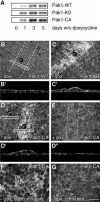
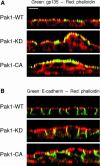
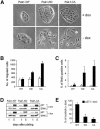
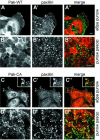



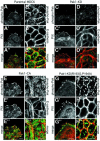
Similar articles
-
Targeting and activation of Rac1 are mediated by the exchange factor beta-Pix.J Cell Biol. 2006 Feb 27;172(5):759-69. doi: 10.1083/jcb.200509096. Epub 2006 Feb 21. J Cell Biol. 2006. PMID: 16492808 Free PMC article.
-
A PAK1-PIX-PKL complex is activated by the T-cell receptor independent of Nck, Slp-76 and LAT.EMBO J. 2001 Feb 1;20(3):457-65. doi: 10.1093/emboj/20.3.457. EMBO J. 2001. PMID: 11157752 Free PMC article.
-
p85 beta-PIX is required for cell motility through phosphorylations of focal adhesion kinase and p38 MAP kinase.Exp Cell Res. 2005 Jul 15;307(2):315-28. doi: 10.1016/j.yexcr.2005.03.028. Exp Cell Res. 2005. PMID: 15893751
-
AlphaPIX and betaPIX and their role in focal adhesion formation.Eur J Cell Biol. 2006 Apr;85(3-4):265-74. doi: 10.1016/j.ejcb.2005.10.007. Epub 2005 Dec 5. Eur J Cell Biol. 2006. PMID: 16337026 Review.
-
The PIX-GIT complex: a G protein signaling cassette in control of cell shape.Semin Cell Dev Biol. 2008 Jun;19(3):234-44. doi: 10.1016/j.semcdb.2008.01.002. Epub 2008 Jan 20. Semin Cell Dev Biol. 2008. PMID: 18299239 Free PMC article. Review.
Cited by
-
Pak1 regulates the orientation of apical polarization and lumen formation by distinct pathways.PLoS One. 2012;7(7):e41039. doi: 10.1371/journal.pone.0041039. Epub 2012 Jul 18. PLoS One. 2012. PMID: 22815903 Free PMC article.
-
Inhibition of cell movement and proliferation by cell-cell contact-induced interaction of Necl-5 with nectin-3.J Cell Biol. 2005 Oct 10;171(1):165-73. doi: 10.1083/jcb.200501090. J Cell Biol. 2005. PMID: 16216929 Free PMC article.
-
Local cell metrics: a novel method for analysis of cell-cell interactions.BMC Bioinformatics. 2009 Oct 23;10:350. doi: 10.1186/1471-2105-10-350. BMC Bioinformatics. 2009. PMID: 19852804 Free PMC article.
-
Roles of P21-activated kinases and associated proteins in epithelial wound healing.Int Rev Cell Mol Biol. 2008;267:253-98. doi: 10.1016/S1937-6448(08)00606-0. Int Rev Cell Mol Biol. 2008. PMID: 18544501 Free PMC article. Review.
-
Identification of MYO18A as a novel interacting partner of the PAK2/betaPIX/GIT1 complex and its potential function in modulating epithelial cell migration.Mol Biol Cell. 2010 Jan 15;21(2):287-301. doi: 10.1091/mbc.e09-03-0232. Epub 2009 Nov 18. Mol Biol Cell. 2010. PMID: 19923322 Free PMC article.
References
-
- Bagrodia S. and Cerione,R.A. (1999) Pak to the future. Trends Cell Biol., 9, 350–355. - PubMed
-
- Bagrodia S., Taylor,S.J., Jordon,K.A., Van Aelst,L. and Cerione,R.A. (1998) A novel regulator of p21-activated kinases. J. Biol. Chem., 273, 23633–23636. - PubMed
-
- Bagrodia S., Bailey,D., Lenard,Z., Hart,M., Guan,J.L., Premont,R.T., Taylor,S.J. and Cerione,R.A. (1999) A tyrosine-phosphorylated protein that binds to an important regulatory region on the cool family of p21-activated kinase-binding proteins. J. Biol. Chem., 274, 22393–22400. - PubMed
Publication types
MeSH terms
Substances
Grants and funding
LinkOut - more resources
Full Text Sources
Other Literature Sources
Molecular Biology Databases
Research Materials
Miscellaneous

